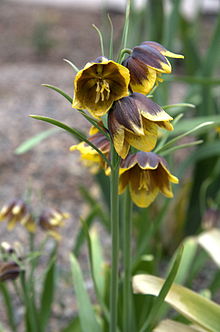Fritillaria reuteri is a perennial herbaceous bulbous plant, distributed in Turkey and Iran.[4][5] It is a species in the genus Fritillaria, in the family Liliaceae.[6] It is placed in the subgenus Fritillaria.
| Fritillaria reuteri | |
|---|---|

| |
| Scientific classification | |
| Kingdom: | Plantae |
| Clade: | Tracheophytes |
| Clade: | Angiosperms |
| Clade: | Monocots |
| Order: | Liliales |
| Family: | Liliaceae |
| Subfamily: | Lilioideae |
| Tribe: | Lilieae |
| Genus: | Fritillaria |
| Species: | F. reuteri
|
| Binomial name | |
| Fritillaria reuteri | |
Description
editFritillaria reuteri is characterised by purplish-brown flowers, tall stems, and narrow leaves. Each pedicel bears two bracts at the base.[5] It flowers from May to June.[7]
Taxonomy
editIt was described by Boissier in 1844,[1] Baker (1874), who divided Fritillaria into subgenera, placed F. reuteri in subgenus Monocodon, a subgenus later subsumed into Fritillaria.[8] Modern classifications, based on molecular phylogenetics, confirm this placement.[9]
Distribution and habitat
editThis plant inhabits high mountainous areas west of Esfahan, Iran, in wet soil or running water.[5]
References
edit- ^ a b Boissier 1844.
- ^ TPL 2013.
- ^ IPNI 2005.
- ^ WCSP 2017.
- ^ a b c AGS 2017.
- ^ "Fritillaria reuteri Boiss". Plants of the World Online. The Trustees of the Royal Botanic Gardens, Kew. n.d. Retrieved September 6, 2020.
- ^ Kiani et al 2017.
- ^ Baker 1874.
- ^ Day et al 2014.
Bibliography
edit- Baker, J. G. (1874). "Revision of the Genera and Species of Tulipeae". Botanical Journal of the Linnean Society. XIV (76). F. reuteri p. 256. doi:10.1111/j.1095-8339.1874.tb00314.x.
- Boissier, E (1844). "Liliaceae: Fritillaria reuteri". Diagnoses Plantarum Orientalium Novarum. 5: 57–58.
- Day, Peter D.; Berger, Madeleine; Hill, Laurence; Fay, Michael F.; Leitch, Andrew R.; Leitch, Ilia J.; Kelly, Laura J. (November 2014). "Evolutionary relationships in the medicinally important genus Fritillaria L. (Liliaceae)". Molecular Phylogenetics and Evolution. 80: 11–19. doi:10.1016/j.ympev.2014.07.024. PMID 25124097.
- Kiani, Mahmoud; Mohammadi, Shirin; Babaei, Alireza; Sefidkon, Fatemeh; Naghavi, Mohamad Reza; Ranjbar, Mojtaba; Razavi, Seyed Ali; Saeidi, Keramatollah; Jafari, Hadi; Asgari, Davoud; Potter, Daniel (September 2017). "Iran supports a great share of biodiversity and floristic endemism for Fritillaria spp. (Liliaceae): A Review". Plant Diversity. 39 (5): 245–262. doi:10.1016/j.pld.2017.09.002. PMC 6112302. PMID 30159518.
Databases
edit- TPL (2013). "The Plant List 1.1: Fritillaria reuteri Boiss". Royal Botanic Gardens, Kew and Missouri Botanical Garden. Retrieved 16 October 2017.
- WCSP. "Fritillaria reuteri Boiss.". World Checklist of Selected Plant Families (WCSP). Royal Botanic Gardens, Kew. Retrieved 11 October 2017.
- IPNI (2005). "Fritillaria reuteri Boiss.". International Plant Names Index. Retrieved 24 October 2017.
- "Fritillaria reuteri". Fritillaria species: R-S. Fritillaria Group, Alpine Garden Society. Retrieved 17 October 2017.
- Roskov Y.; Kunze T.; Orrell T.; Abucay L.; Paglinawan L.; Culham A.; Bailly N.; Kirk P.; Bourgoin T.; Baillargeon G.; Decock W.; De Wever A.; Didžiulis V., eds. (2014). "Fritillaria reuteri Boiss". Species 2000 & ITIS Catalogue of Life: 2014 Annual Checklist. Naturalis, Leiden, the Netherlands: ITIS, Royal Botanic Gardens, Kew. Retrieved 23 October 2017.
- "Fritillaria reuteri Boiss". eMonocot. Royal Botanic Gardens, Kew. Retrieved 30 October 2017.
- Media related to Fritillaria reuteri at Wikimedia Commons